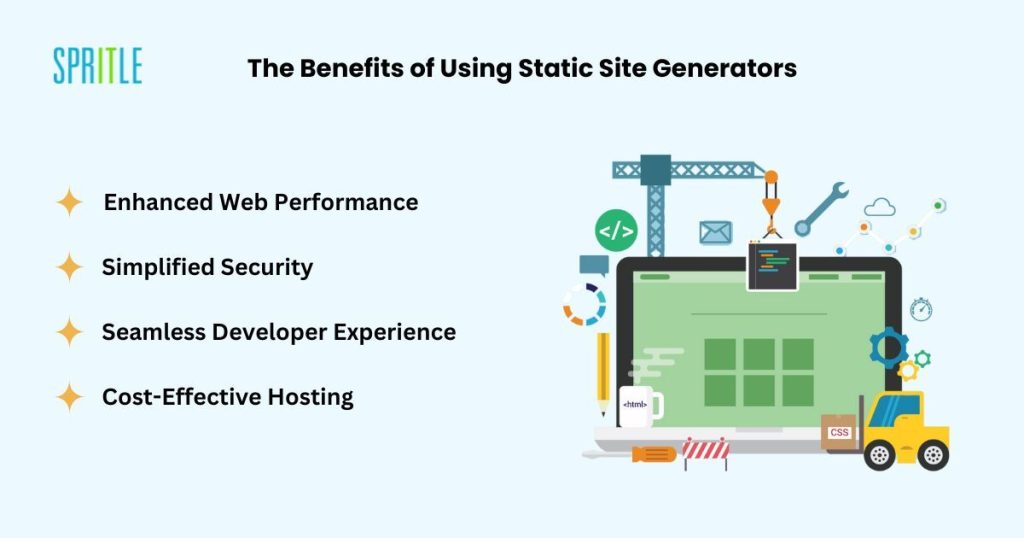
Introduction
In the fast-evolving world of web development, achieving the perfect balance between speed and functionality has always been a challenge. Users expect lightning-fast load times and seamless experiences, while developers strive to build rich, interactive websites. This is where Static Site Generators (SSGs) come into play, offering a promising solution to bridge this gap.
In this blog, we’ll explore how SSGs can elevate web performance, optimize your web projects, and turn your development workflow into a developer’s paradise.
What Are Static Site Generators?
Static Site Generators are tools that compile raw content files (like Markdown or HTML) and templates into a complete static website. Unlike traditional Content Management Systems (CMS) like WordPress, which build pages on-the-fly for each request, SSGs generate the entire website at build time.
This results in pre-rendered HTML files that can be served directly from a CDN, offering unparalleled speed and reliability.
How Static Site Generators Work
1. Content Creation: Content is typically written in Markdown, HTML, or another markup language.
2. Template Application: Templates are applied to the content to generate HTML files.
3. Build Process: The site is compiled during the build process, producing static files (HTML, CSS, JavaScript).
4. Deployment: These static files are then deployed to a web server or a CDN.
Popular SSGs include Jekyll, Hugo, Next.js (for static exports), and Gatsby. Each of these tools has its strengths, catering to different needs and preferences of developers.
The Benefits of Using Static Site Generators
1. Enhanced Web Performance
One of the most significant advantages of using SSGs is the boost in web performance. Since the HTML files are pre-generated, there’s no need for server-side processing when a user requests a page. This results in faster load times and a smoother user experience.
- Reduced Server Load: With pre-rendered pages, the server is relieved of the burden of generating content dynamically, allowing it to handle more requests simultaneously.
- Faster Page Load Times: Static sites can be served directly from a CDN, minimizing latency and delivering content to users swiftly.
- Improved SEO: Search engines favor fast-loading websites, giving static sites an edge in search rankings.
2. Simplified Security
Static sites are inherently more secure than their dynamic counterparts. Since there’s no backend to exploit, the attack surface is significantly reduced. This makes SSGs an excellent choice for websites where security is a paramount concern.
- No Database Vulnerabilities: Static sites do not require databases, eliminating the risk of SQL injection attacks. Reduced Maintenance: Fewer components mean fewer updates and patches to apply, simplifying the maintenance process.
3. Seamless Developer Experience
For developers, SSGs offer a streamlined and enjoyable workflow. By focusing on writing content and code without worrying about backend complexities, developers can be more productive and creative.
- Version Control Integration: Static sites work well with Git, allowing developers to track changes, collaborate efficiently, and roll back to previous versions effortlessly.
- Easy Content Management: With Markdown or other markup languages, content creation becomes straightforward, allowing even non-developers to contribute.
- Flexible Hosting Options: Static sites can be hosted on various platforms, including GitHub Pages, Netlify, and Vercel , often for free.
4. Cost-Effective Hosting
Static sites are cheaper to host because they require minimal server resources. Many static site hosting providers offer generous free tiers, making it an economical choice for personal blogs, small business websites, and documentation sites.
- Reduced Hosting Costs: With lower server resource requirements, hosting providers can offer more affordable plans.
- Scalability: Static sites can handle high traffic volumes without requiring complex infrastructure, making them highly scalable.

Challenges and Solutions
While Static Site Generators offer numerous benefits, they are not without challenges. However, these can often be mitigated with the right approach.
1. Lack of Dynamic Content
SSGs are inherently static, which can be a limitation for sites requiring dynamic content such as user-generated content or real-time updates.
- Solution: Use APIs and JavaScript to fetch and display dynamic content on the client side. Combining SSGs with serverless functions or third-party services can bring dynamic capabilities to static sites.

2. Build Time for Large Sites
For very large websites, the build process can become time-consuming as the number of pages increases.
- Solution: Incremental builds and caching strategies can significantly reduce build times. Tools like Gatsby Cloud and Netlify offer solutions to manage large-scale static sites efficiently.

3. Learning Curve
Developers new to SSGs may face a learning curve, especially when transitioning from traditional CMS platforms.
- Solution: Leverage the rich ecosystems and community support around popular SSGs. Documentation, tutorials, and community forums can accelerate the learning process.

Case Studies: Success Stories with SSGs
1. Smashing Magazine
Smashing Magazine, a popular web development resource, transitioned from WordPress to a static site built with Hugo. The result was a faster, more secure site that handled high traffic volumes effortlessly. This move significantly improved their web performance and reduced hosting costs.
2. GitHub Documentation
GitHub uses Jekyll for its extensive documentation, showcasing the power of SSGs for managing large volumes of content efficiently. The static site approach ensures fast load times and easy scalability.
Getting Started with Static Site Generators
Ready to dive into the world of SSGs? Here’s a quick guide to get you started:
1. Choose an SSG: Select an SSG that fits your needs. Jekyll and Hugo are great for blogs and documentation, while Next.js and Gatsby are ideal for more complex projects.
2. Set Up Your Development Environment: Install the necessary tools and dependencies. Most SSGs have excellent documentation to guide you through the setup process.
3. Create Your First Page: Write your content in Markdown or your preferred format and use templates to style your site.
4. Build and Deploy: Generate your static site and deploy it to a hosting platform. Services like Netlify and Vercel offer seamless deployment for static sites.
Conclusion
Static Site Generators represent a paradigm shift in web development, offering a perfect blend of speed, security, and functionality. By pre-rendering content and serving it as static files, SSGs significantly enhance web performance and provide a simplified, cost-effective solution for developers. Whether you’re building a personal blog, a business website, or comprehensive documentation, SSGs can transform your development workflow into a developer’s paradise.
Embrace the power of Static Site Generators and bridge the gap between speed and functionality in your web projects. Start exploring the possibilities today, and take your web development skills to new heights.
